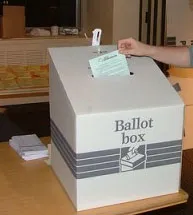Question 2: Red Flag Firearm Law
This measure would allow family members and law enforcement to prohibit people who pose a significant danger of causing physical harm to themselves or others from having dangerous weapons.
5 minute read
The gist
This resolution would initiate the Extreme Risk Protection Order Act, which would allow family, household members, or law enforcement to petition the courts to determine whether to issue an order prohibiting someone who they believe could pose significant danger or harm to themselves or others from possessing dangerous weapons.
Ballot question
Do you want to allow courts to temporarily prohibit a person from having dangerous weapons if law enforcement, family, or household members show that the person poses a significant danger of causing physical injury to themselves or others?
Yes means
I am in favor of a court ordered process to prohibit at-risk persons from temporarily purchasing, receiving, or possessing any dangerous weapons at the request of family or household members.
No means
I don't want to allow a court ordered process to prohibit at-risk persons from temporarily purchasing, receiving, or possessing any dangerous weapons at the request of family or household members.
Tell me more
This question would establish a “red flag” system to allow a judge to prohibit at-risk persons, in the judge’s informed reasoning, from having control of weapons that the at-risk person may use on themselves, their family, or the community. It goes further than the current “yellow flag” system which is primarily driven by communications between medical and law enforcement personnel through the use of protective custody for a mental health evaluation.1
The main difference between the “yellow flag” and “red flag” is that the family would now be allowed to petition the courts for the potentially at-risk person from being prohibited to possess weapons.2
Both systems were born from recognition of an established pattern of mass shootings across the United States and most especially after the Lewiston, ME shootings on October 25th, 2023. While the “yellow flag” system was already in place by the time of the Lewiston shootings, the system was strengthened shortly after.3
Both systems bring up important constitutional questions regarding the second and fourth amendments. The second amendment allowing for the right to bear arms and the fourth amendment allowing for the right to due process. Protective order laws have yet to be ruled on by the Supreme Court, but generally the state and federal courts have allowed for extremely limited and temporary restrictions on control of firearms if there is a extreme risk to the individual or the community.4
This question is a citizen’s initiative, which is a way for Mainers to propose new laws. In order to become a valid initiative, a petition supporting the initiative must collect over 60,000 signatures.
Follow the money
The money will be used to
- $1,126,000 per year to establish 2 Judge positions, 2 Marshal positions and 2 Assistant Clerk positions to handle the increased workload expected to be generated by the extreme risk protection order process5
- $76,000 for system programming updates and for temporary contracted staffing to manage the additional filings prior to electronic implementation of the process5
- There may be additional costs to state, county, tribal, municipal or University of Maine System law enforcement agencies for the collection and storage of firearms5
- There may also be an increased demand for state-provided counsel to represent indigent individuals5
The money will be coming from
- General fund appropriations: $1,126,000 per year5
- One-time general fund appropriations: $76,0005
- State, county, tribal, municipal or University of Maine System law enforcement agencies, the availability of these funds is unknown.5
Pros
The primary arguments for this referendum are:
- It could prevent gun violence and suicides.5
- It gives people close to people who might become threats a way to do something about their concerns. Family and household members are often the first to know that someone is a threat. 56
- Similar laws exist in 21 states and the District of Columbia.6
Cons
The primary arguments against this referendum are:
- The existing “yellow flag” law requires more due process.6
Who cares
Support
- Safe Schools, Safe Communities5
- The Maine Gun Safety Coalition7
- Alliance for Gun Responsibility7
- Episcopal Diocese of Maine7
- Global Impact Social Welfare Fund 7
- Maine Medical Association7
- Responsible Gun Owners of Maine7
Opposition
- The Sportsman’s Alliance of Maine6
- The Protect Me — No Red Flag committee6
- Gun Owners of Maine6
- The Keep Maine Safe committee6
Further reading
References
-
Maine State Legislature. Title 34-B. §3862-A. Extreme risk protection orders. Accessed September 26, 2025. ↩
-
Maine Public. Maine’s ‘yellow flag’ law could be a model for gun control, but legal experts say it has limitations. Accessed September 26, 2025. ↩
-
Maine Law Review. Cars Don’t Stop for Yellow Lights: Turning Maine’s Yellow Flag Law Red. Accessed September 26, 2025. ↩
-
Duke Center for Firearms Law. Extreme Risk Protection Orders in the Post-Bruen Age. Accessed September 26, 2025. ↩
-
Bellows, Shenna. Maine Citizen’s Guide to the Referendum Election. Accessed October 5, 2024. ↩ ↩2 ↩3 ↩4 ↩5 ↩6 ↩7 ↩8 ↩9 ↩10
-
Ohm, Rachel. Question 2 asks voters to support $25 million research-and-development bond. Portland Press Herald. Accessed October 5, 2024. ↩ ↩2 ↩3 ↩4 ↩5 ↩6 ↩7
-
Ballotpedia State Desk. Maine Question 2, Science and Technology Research and Commercialization Bond Issue (2024). Ballotpedia. Accessed October 5, 2024. ↩ ↩2 ↩3 ↩4 ↩5 ↩6
Related ballot questions

Question 1: Voter ID and Absentee Ballot Changes
This measure would require a photo ID to vote and make absentee voting more difficult.
